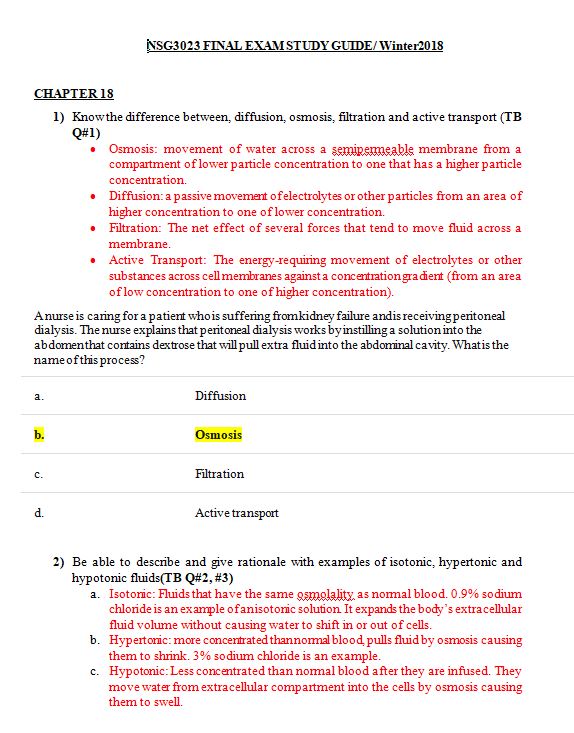Description
NSG 3023 FINAL EXAM STUDY GUIDE/ Winter 2018
CHAPTER 18
- Know the difference between, diffusion, osmosis, filtration and active transport (TB Q#1)
- Be able to describe and give rationale with examples of isotonic, hypertonic and hypotonic fluids(TB Q#2, #3)
- Be able to describe the mechanism behind thirst(TB Q#4)
- Describe insensible water loss and the effects on particular organs (TB Q#5)
- Be able to describe the mechanism in which fluid and electrolyte balance is maintained or regulated partially by hormones(TB Q#7)
- Educations for clients at risk for hyperthermia.ie; (hypothalamus injury)
- A head injury could result in injury of hypothalamus or pituitary which could affect which organsor functions? (TB Q#8)
- Be able to describe signs and symptoms of hyponatremia, hypokalemia, and hypochloremia.(TB Q#9)
- What concerns would a health care provider anticipate with a patient on a ventilator related to acid base imbalance?(TB Q#10)
- Be able to look at labs and distinguish between respiratory acidosis & alkalosis also metabolic acidosis and alkalosis by reading results of arterial blood gases (know the appropriate ranges of arterial blood gases)(TBQ#11, 12 and 13)
- What makes the most sense for fluid allotment times for a client with low sodium diet and fluid restriction?(TBQ#18)
- Know when it is appropriate to administer an implanted port, peripheral IV catheter, central line or a peripherally inserted central catheter(TB Q#21)
- Know the steps to starting a peripheral intravenous catheter
- What is the best method to administer nutrition for a client with no bowel sounds?(TBQ#19)
- Know the signs of phlebitis, infiltration, thrombophlebitis, and local inflammation(TBQ#24)
- Know the procedure when experiencing a blood transfusion reaction and also if the nurse wants to keep the access open(TBQ#26)
CHAPTER 37
- Know the difference between reactive hyperemia, blanchable-hyperemia, nonblanchable hyperemia and tissue ischemia (TBQ#1)
- Know the difference between friction and shear on the skin, also tunneling and moisture effects (TBQ#2)
- What factors could put a client at risk for pressure ulcers (TBQ#3)
- What parameters are assessed when doing a wound assessment? (TBQ#2 select all that apply)
- Be able to identify the categories and familiarity with the Braden Scale (TBQ#1 select all that apply)
- Be able to describe pressure ulcer staging (1-4). (TBQ# 4-7)
- What is the time frame for administration of a tetanus toxoid injection? (TBQ#8)
- Know and describe maceration, dehiscence, evisceration and debridement (TBQ#9)
- Know the uses of wound care products ie; dry gauze, transparent film, hydrogel and hydrocolloid (TBQ#10)
- Know the order of steps to change a large buttock wound (TBQ#11)
- Know the purpose of the therapies; warm soaks, warm moist compresses, sitz baths, and cold moist compresses and dry heat therapy (TBQ#12)
- Know the various stages of wound healing and what is happening at each phase (TBQ#13)
- Documentation for a client with an abdominal binder post-surgery (TBQ#15)
- Know the difference between serous, seroussanguineous, sanguineous and purulent drainage (TBQ#16)
- Proper way to wrap an elastic bandage (TBQ#19)
Chapter 39
- Biggest post op concern for a client (TBQ#1)
- Know the profile of a client who is more prone to suffer from a pulmonary embolism (TBQ#2)
- When is the best time to facilitate a client’s wound healing that was post radio and chemotherapy? (TBQ#3)
- What type of client is most at risk for hypovolemic shock after emergency therapy? (TBQ#4)
- Rationale for monitoring a client’s glucose level that is post-op, and not diabetic (TBQ#5)
- What are early and late signs of malignant hyperthermia (TBQ#6)
- When should preoperative teaching begin for a newly diagnosed client (TBQ#7)
- Proper times for a surgeon to clarify information with a patient undergoing surgery (Select all that apply #1)
- When should prior to surgery general anesthesia fast begin? (TBQ#8)
- Why do post op clients perform leg exercises? (TBQ#10)
- What does ruptured AAA (aortic abdominal aneurysm) major surgery entail? (TBQ#11)
- Why do clients often shiver after surgery? (TBQ#13)
- Be able to distinguish between local, regional, and general anesthesia as well as moderate sedation (TBQ#14)
- Teaching about postoperative analgesia (Select all that apply #2) nsg 3023 final exam
- Why is postoperative coughing important? (Select all that apply #3)
- What does physical preoperative preparation entail? (TBQ#15)
- Be able to use and explain the overall function of the incentive spirometer (TBQ#18)
- Factors which may contribute to an inaccurate oxygen saturation reading
- Write a correct outcome statement for a client ie; SOB, nutrition, mobility
- What happens when a client does not meet the nurses’ stated outcomes?
- What steps does a nurse take when evaluating care for a patient?
- Be able to identify leadership skills that nursing students use when caring for patients
- Be able to describe various ways for the staff, family, patient etc…to all work on goals
Chapter 13
- Be able to prioritize patient care using Maslow’s and the ABC’s. (TBQ#17)
- Be able to describe terminology for a person having a low or increased temperature out of range******
Chapter 15
- Difference between systolic and diastolic pressure? (TBQ#36)
- Abnormal heart rates, blood pressure and rhythms names and meanings (TBQ# 32-38) nsg 3023 final exam
- Conditions which would make a nurse be concerned with orthostatic hypotension and interventions for the nurse to do if a client is experiencing the symptoms.
Chapter 27
- Be able to describe the best way to ambulate a hemiplegic patient (TBQ#23)
Chapter 38
- Know the difference between sensory deficit, overload, and deprivation (TBQ#17)
- Interventions to assist a client that is suffering from sensory overload (Select all that apply #3)
- Know what to look for the presence of to assess sensory alterations (Select all that apply #2)
Chapter 18
- What processes with body fluids maintains homeostasis? (Select all that apply #1)
- Be able to calculate lbs, kgs, and liters

